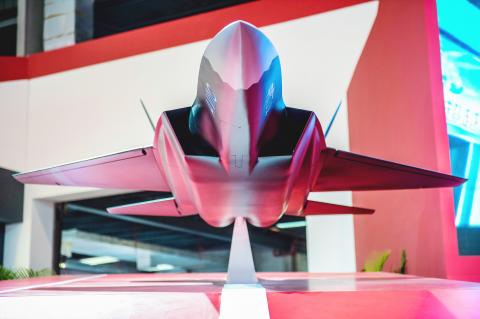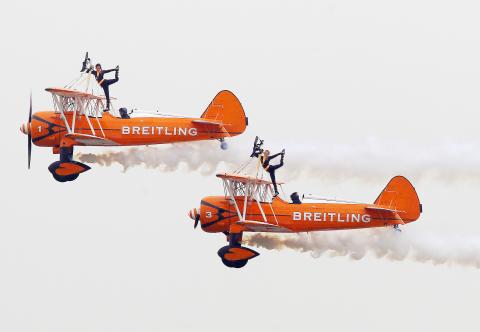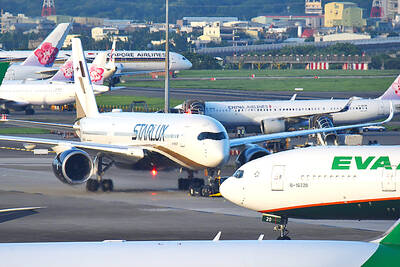China announced 50 new orders for its new Comac C919 passenger jet at the opening of the country’s main air show yesterday and looked set to assist in the rebirth of one of the most famous names in aviation — defunct US carrier Eastern Air Lines.
The dozens of new orders for China’s first large commercial passenger jet were seen dominating the first day of the China International Aviation and Aerospace Exhibition, held every two years in the southern city of Zhuhai, along with fresh evidence of China’s military ambitions.
The latest orders for the 150-seat plane will boost the official total to 380, reaching the state-owned manufacturer’s declared breakeven point of 300 to 400 orders. However, Western analysts say it will be some time before the aircraft, due to make its maiden flight in 2014, proves its viability.

Photo: AFP
The C919 is designed to challenge Airbus SAS and Boeing Co in the largest segment of the US$100 billion annual jetliner market.
Commercial Aircraft Corp of China (COMAC, 中國商用飛機) yesterday said it would sign orders for 20 aircraft each with Joy Air and Hebei Aviation Group, confirming a Reuters report of buying interest from the two Chinese regional carriers.
Its only foreign customer, GECAS, a unit of General Electric Co which co-produces the engines, will buy 10 more, taking its total order for the plane to 20, COMAC said in a statement.

Photo: Reuters
Other potential C919 customers that have already signed tentative agreements include Irish low-cost carrier Ryanair and British Airways, COMAC said.
COMAC also confirmed it would sign a provisional agreement with investors representing Eastern Air Lines, which went bankrupt in 1991. There have been sporadic reports of efforts to relaunch the airline, whose forked logo was seen on display as a backdrop to the signing ceremony due later yesterday.
Once led by former World War I ace Eddie Rickenbacker and later by former Apollo astronaut Frank Borman, Miami-based Eastern Air Lines rose to become one of the largest airlines in the world before losing a battle against low-cost competition.
The air show — attended by a record 650 exhibitors — also featured prototypes of a new Chinese business aircraft and a model of a new stealth fighter China hopes to build for export.
Industry publication Aviation Week noted the model bore a “striking resemblance” to an aircraft recently photographed flying from the Shenyang Aircraft factory, which captured worldwide interest from military analysts and publications.
Separately, Airbus said it expects to build the planned A320neo jet in China, as the planemaker holds discussions about extending the life of its first assembly line outside Europe.
The company is in talks with partners about operating the Tianjin, China, facility through 2025, Airbus’ China head Laurence Barron said yesterday at a press briefing. The factory already makes the current A320 model.
“We can expect to see the neo being assembled here in China in the near future,” Barron said.
The aircraft is due to enter service in 2015. Airbus also builds A320s in France and Germany, and is planning to open a factory in Alabama in the US.
Barron also said the EU’s decision to suspend the introduction of emissions levies on foreign carriers is positive for Airbus in China. The country had been among nations opposing the EU plan because of sovereignty and cost concerns.

RECYCLE: Taiwan would aid manufacturers in refining rare earths from discarded appliances, which would fit the nation’s circular economy goals, minister Kung said Taiwan would work with the US and Japan on a proposed cooperation initiative in response to Beijing’s newly announced rare earth export curbs, Minister of Economic Affairs Kung Ming-hsin (龔明鑫) said yesterday. China last week announced new restrictions requiring companies to obtain export licenses if their products contain more than 0.1 percent of Chinese-origin rare earths by value. US Secretary of the Treasury Scott Bessent on Wednesday responded by saying that Beijing was “unreliable” in its rare earths exports, adding that the US would “neither be commanded, nor controlled” by China, several media outlets reported. Japanese Minister of Finance Katsunobu Kato yesterday also

China Airlines Ltd (CAL, 中華航空) said it expects peak season effects in the fourth quarter to continue to boost demand for passenger flights and cargo services, after reporting its second-highest-ever September sales on Monday. The carrier said it posted NT$15.88 billion (US$517 million) in consolidated sales last month, trailing only September last year’s NT$16.01 billion. Last month, CAL generated NT$8.77 billion from its passenger flights and NT$5.37 billion from cargo services, it said. In the first nine months of this year, the carrier posted NT$154.93 billion in cumulative sales, up 2.62 percent from a year earlier, marking the second-highest level for the January-September

‘DRAMATIC AND POSITIVE’: AI growth would be better than it previously forecast and would stay robust even if the Chinese market became inaccessible for customers, it said Taiwan Semiconductor Manufacturing Co (TSMC, 台積電) yesterday raised its full-year revenue growth outlook after posting record profit for last quarter, despite growing market concern about an artificial intelligence (AI) bubble. The company said it expects revenue to expand about 35 percent year-on-year, driven mainly by faster-than-expected demand for leading-edge chips for AI applications. The world’s biggest contract chipmaker in July projected that revenue this year would expand about 30 percent in US dollar terms. The company also slightly hiked its capital expenditure for this year to US$40 billion to US$42 billion, compared with US$38 billion to US$42 billion it set previously. “AI demand actually

Jensen Huang (黃仁勳), founder and CEO of US-based artificial intelligence chip designer Nvidia Corp and Taiwan Semiconductor Manufacturing Co (TSMC, 台積電) on Friday celebrated the first Nvidia Blackwell wafer produced on US soil. Huang visited TSMC’s advanced wafer fab in the US state of Arizona and joined the Taiwanese chipmaker’s executives to witness the efforts to “build the infrastructure that powers the world’s AI factories, right here in America,” Nvidia said in a statement. At the event, Huang joined Y.L. Wang (王英郎), vice president of operations at TSMC, in signing their names on the Blackwell wafer to